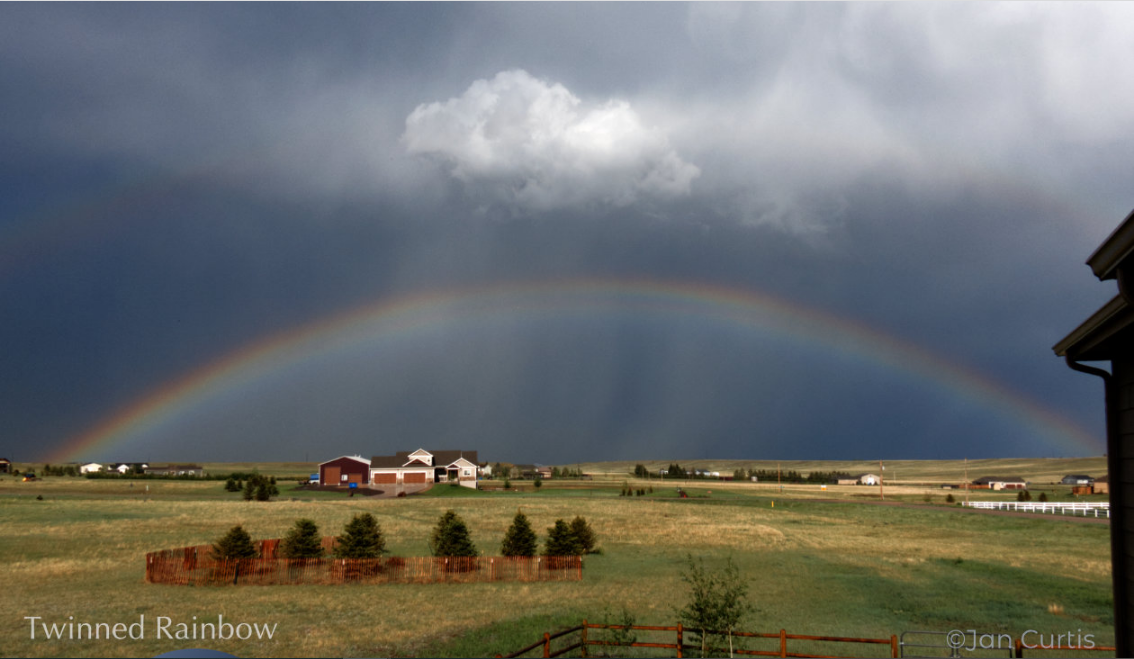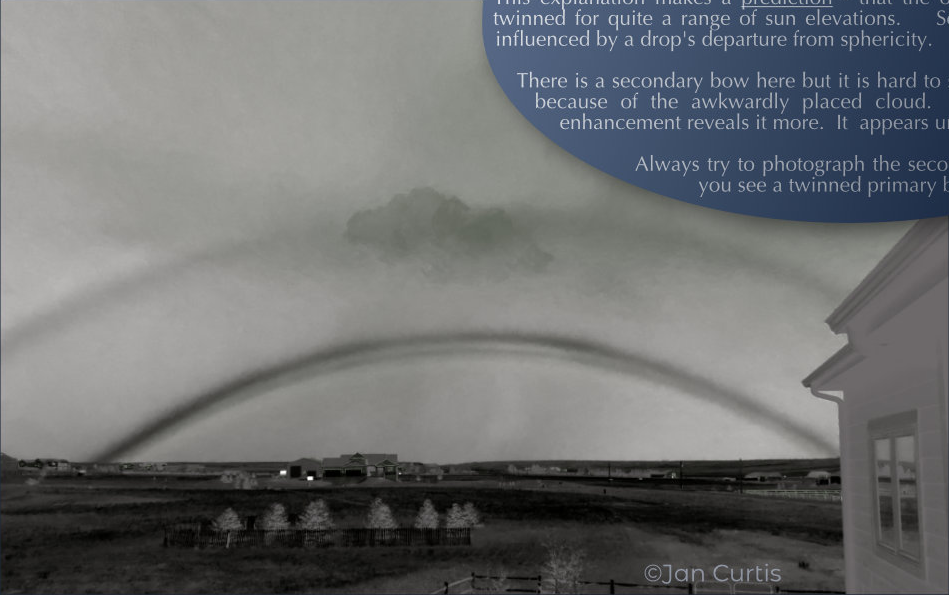Twinned Rainbow, Wyoming - Atoptics Highlights OPOD
Twinned Rainbow, Wyoming - Atmospheric Optics Highlights OPOD
Rainbows have long captivated our imagination with their vibrant colors and ethereal beauty. But have you ever heard of a twinned rainbow? This rare atmospheric phenomenon occurs when the inner, primary rainbow splits into two distinct arcs. Today, we will explore the fascinating world of twinned rainbows, focusing on a captivating sighting in Wyoming captured by Jan Curtis after a hail storm.
Twinned rainbows are a relatively uncommon sight, often appearing in conjunction with hail and violent storms. However, they can also manifest in calmer weather conditions, adding an element of surprise to our observations. The prevailing theory suggests that twinned rainbows are formed by two sets of raindrops with different sizes and shapes, rather than ice balls or onion-like hailstones as previously speculated.
In this intriguing explanation, small raindrops, which are nearly perfectly spherical, create the familiar primary bow. On the other hand, larger raindrops experience less constraint from surface tension as they fall, causing them to deform and flatten under the influence of air resistance. These larger drops also exhibit wobbling and oscillating motions during their descent. In certain circumstances, these peculiar characteristics of the larger drops lead to the formation of the lower arc of the twinned rainbow.
One interesting aspect of this explanation is that the two types of raindrops responsible for creating the twinned rainbow need not be present in the same rain sheet. This suggests that the conditions required for the formation of twinned rainbows are more complex than initially thought, adding to the mystique surrounding this optical phenomenon.
A key prediction arising from this explanation is that the outer secondary bow of a twinned rainbow should not exhibit twinning over a range of sun elevations. This is because the rays of light forming the secondary bow are less influenced by a raindrop's departure from sphericity compared to those forming the primary bow. Therefore, careful observation and photography of the secondary bow when a twinned primary bow is present can provide valuable insights into the nature of this captivating atmospheric event.
Returning to the twinned rainbow sighting in Wyoming, the presence of an obstructing cloud makes it challenging to ascertain whether the secondary bow is also twinned. However, through the use of color subtraction enhancement techniques, it becomes possible to discern the presence of the secondary bow more clearly, even if it appears un-twinned in this particular instance.
In conclusion, twinned rainbows continue to captivate and intrigue both casual observers and scientific researchers alike. While their association with hail and violent storms is well-documented, they can also manifest under calmer weather conditions, adding an element of unpredictability to their occurrence. The prevailing explanation attributes the formation of twinned rainbows to two sets of raindrops with different sizes and shapes. However, the exact conditions necessary for their creation remain a subject of ongoing investigation.
So, the next time you spot a primary twinned rainbow, remember to keep an eye out for its secondary counterpart. By studying and documenting these captivating atmospheric optics phenomena, we can further our understanding of the intricate interplay between light, water droplets, and the natural world around us.

Jan Curtis captured this in Wyoming after a hail storm. The inner, primary, rainbow is split into two or twinned
Twinned bows are fairly rare and they seem to like hail and violent storms but not always. They are sometimes seen in calmer weather.
The association with hail suggested that perhaps ice balls make one bow and rain drops the other. Problem - ice balls and certainly onion-like hailstones just lack the necessary optical quality.
The favoured explanation is that two sets of raindrops of different size and shape make the twins. The two types need not be in the same rain sheet.
Small drops are near perfectly spherical and form a normal bow. Large drops are constrained less by surface tension and deform as they fall. Air resistance flattens their lower section. They also wobble and oscillate. Under some circumstances the big drops form the lower of the twin bows.
This explanation makes a prediction that the outer secondary bow is not twinned for quite a range of sun elevations. Secondary bow rays are less influenced by a drop's departure from sphericity.
There is a secondary bow here but it is hard to see whether it is twinned because of the awkwardly placed cloud. Colour subtraction enhancement reveals it more. It appears un-twinned.
Always try to photograph the secondary whenyou see a twinned primary bow.

Note: this article has been automatically converted from the old site and may not appear as intended. You can find the original article here.
Reference Atmospheric Optics
If you use any of the definitions, information, or data presented on Atmospheric Optics, please copy the link or reference below to properly credit us as the reference source. Thank you!
-
<a href="https://atoptics.co.uk/blog/twinned-rainbow-wyoming-atoptics-highlights-opod/">Twinned Rainbow, Wyoming - Atoptics Highlights OPOD</a>
-
"Twinned Rainbow, Wyoming - Atoptics Highlights OPOD". Atmospheric Optics. Accessed on April 16, 2024. https://atoptics.co.uk/blog/twinned-rainbow-wyoming-atoptics-highlights-opod/.
-
"Twinned Rainbow, Wyoming - Atoptics Highlights OPOD". Atmospheric Optics, https://atoptics.co.uk/blog/twinned-rainbow-wyoming-atoptics-highlights-opod/. Accessed 16 April, 2024
-
Twinned Rainbow, Wyoming - Atoptics Highlights OPOD. Atmospheric Optics. Retrieved from https://atoptics.co.uk/blog/twinned-rainbow-wyoming-atoptics-highlights-opod/.